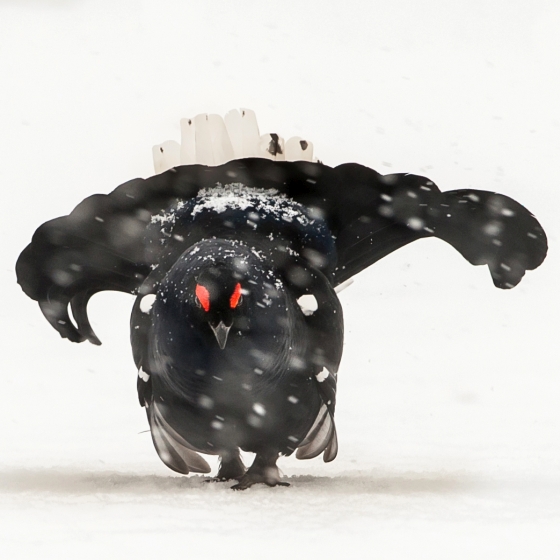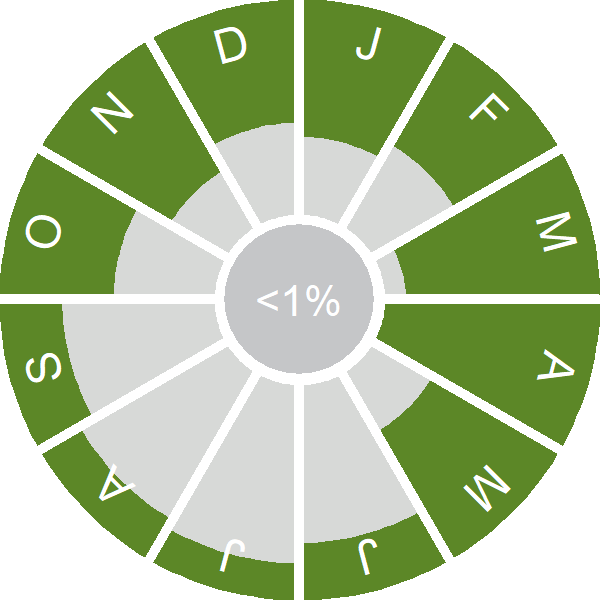Black Grouse

Introduction
A grouse of moorland and forest edge, the Black Grouse is best known for its spring-time gatherings, called 'leks', where the males gather to compete for females.
Males are jet black with long curved tail feathers. They have a slim white stripe in the wing and white feathers under the tail. Females are cryptically camouflaged with finely barred brown and black plumage.
Black Grouse favour moorland habitats that are near to woodland, and the species initially benefited from the planting of commercial forestry plantations following the Second World War. Now these plantations have matured they have become unsuitable for the species. Changes in land management have taken a toll on the population in modern times.

Key Stats
Identification
ID Videos
This section features BTO training videos headlining this species, or featuring it as a potential confusion species.
Grouse
Songs and Calls
Song:
Call:
Flight call:
Other:
Status and Trends
Conservation Status
Population Change
The Black Grouse was once common across the UK but has been in long-term decline and it is now restricted to upland areas of Britain, with the latest estimate putting the population at 4,850 pairs (APEP4). Recent surveys show a significant decline occurred in Scotland between 1995–96 and 2005; Numbers rose in Wales over the same period; however, the Welsh birds make up only 4% of the UK population (Sim et al. 2008). A slight population recovery has occurred in northernEngland between 1998 and 2006 (Warrne & Baines 2008).
Distribution
The Black Grouse is a resident species found in upland areas of Britain, where it favours a mix of moorland fringes, marginal farmland and woodland edge.
Occupied 10-km squares in UK
2007/08–10/11
or view it on Bird Atlas Mapstore.
2008–11
or view it on Bird Atlas Mapstore.
European Distribution Map
Distribution Change
Black Grouse have been lost from many areas of Wales, parts of northern England, southern and central Scotland. A local extinction on Islay is particularly notable. The population in the Peak District became extinct in 2000
Change in occupied 10-km squares in the UK
from 1981–84 to 2007–11
or view it on Bird Atlas Mapstore.
from 1968–72 to 2008–11
or view it on Bird Atlas Mapstore.
Seasonality
Black Grouse are recorded throughout the year, especially in spring when lekking.
Weekly pattern of occurrence
The graph shows when the species is present in the UK, with taller bars indicating a higher likelihood of encountering the species in appropriate regions and habitats.

Movement
Britain & Ireland movement
Foreign locations of birds ringed or recovered in Britain & Ireland
Dots show the foreign destinations of birds ringed in Britain & Ireland, and the origins of birds ringed overseas that were subsequently recaptured, resighted or found dead in Britain & Ireland. Dot colours indicate the time of year that the species was present at the location.
- Winter (Nov-Feb)
- Spring (Mar-Apr)
- Summer (May-Jul)
- Autumn (Aug-Oct)

Biology
Productivity and Nesting
Nesting timing
Egg measurements
Clutch Size
Survival and Longevity
Survival is shown as the proportion of birds surviving from one year to the next and is derived from bird ringing data. It can also be used to estimate how long birds typically live.
View number ringed each year in the Online Ringing Report.
Lifespan
Survival of adults
Survival of juveniles
Biometrics
Wing length and body weights are from live birds (source).
Ring Size
Classification, names and codes
Classification and Codes
- Order: Galliformes
- Family: Phasianidae
- Scientific name: Lyrurus tetrix
- Authority: Linnaeus, 1758
- BTO 2-letter code: BK
- BTO 5-letter code: BLAGR
- Euring code number: 3320
Alternate species names
- Catalan: gall de cua forcada
- Czech: tetrívek obecný
- Danish: Urfugl
- Dutch: Korhoen
- Estonian: teder
- Finnish: teeri
- French: Tétras lyre
- Gaelic: Coileach-dubh
- German: Birkhuhn
- Hungarian: nyírfajd
- Icelandic: Orri
- Italian: Fagiano di monte
- Latvian: rubenis
- Lithuanian: eurazinis tetervinas
- Norwegian: Orrfugl
- Polish: cietrzew (zwyczajny)
- Portuguese: tetraz-lira
- Slovak: tetrov holniak
- Slovenian: ruševec
- Spanish: Gallo lira común
- Swedish: orre
- Welsh: Grugiar Ddu
- English folkname(s): Blackcock (m) Grey Hen (f)
Research
Causes of Change and Solutions
Causes of change
It is believed that habitat and land-use changes have been the main factor responsible to the long-term declines of this species (Sim et al. 2008). A study looking at a core Scottish population in Perthshire found that main driver of change was maturation of forest, which accounted fro 58–78% of the decline within the study area (Pearce-Higgins et al. 2007). Other possible drivers of change include changes in sheep grazing rates which may affect habitat quality (Calladine et al. 2002), and predation levels (Summers et al. 2004). Recent increases in Wales may be due to targeted habitat management (Lindley et al. 2003), whilst recent increases in England were attributed to habitat management, fence marking and reduced levels of sheep grazing on moor fringe habitats (Warren & Baines 2008). Increases in a population in Scotland were attributed to the creation of young non-native woodland and were greatest where non-native woodland plots were c5 years old and made up around 30% of land area, but declines occurred in plots aged more than 20 years (Scridel et al. 2017).
Publications (3)
Birds of Conservation Concern Wales 4: the population status of birds in Wales
Author: Johnstone, I.G., Hughes, J., Balmer, D.E., Brenchley, A., Facey, R.J., Lindley, P.J., Noble, D.G. & Taylor, R.C.
Published: 2022
The latest review of the conservation status of birds in Wales. The report assessed all 220 bird species which regularly occur in Wales. There are now 60 species of bird on the Red List, with 91 on the Amber List and just 69 - less than a third of the total number of species - on the Green List. The latest review of the conservation status of birds in Wales comes 20 years after the first, when the Red List was less than half the length it is today. The report assessed all 220 bird species which regularly occur in Wales. There are now 60 species of bird on the Red List in Wales, with 91 on the Amber List and 69 on the Green List. The Birds of Conservation Concern in Wales report assesses the status of each species against a set of objective criteria. Data sources include the BTO/JNCC/RSPB Breeding Bird Survey and the BTO/RSPB/JNCC Wetland Bird Survey, as well as Bird Atlases and other BTO-led monitoring schemes and citizen science initiatives. These are used to quantify the changing status of the species’ Welsh population. The UK, European and global conservation status of the species is also considered, placing the Welsh population into a wider context. The Red ListSwift, Greenfinch and Rook – familiar breeding species in steep decline across the UK – are among the new additions to the Welsh Red List, which now also includes Purple Sandpiper, on account of a rapidly shrinking Welsh wintering population, and Leach’s Petrel, an enigmatic seabird in decline across its global range. These species now sit alongside well-known conservation priorities, such as Curlew, Hen Harrier and Turtle Dove as birds at risk of being lost from Wales for good. Uplands and woodlands Many of the species on the Red List are found in upland and farmland habitats. Starling, Tree Sparrow, Yellow Wagtail and Yellowhammer can no longer be found in much of Wales, while iconic species of mountain and moorland, such as Ring Ouzel, Merlin and Black Grouse, remain in serious trouble. Wales is well known for its populations of woodland birds; however, many of these – including Lesser Spotted Woodpecker, Willow Warbler and Spotted Flycatcher – also feature on the Red List. Goldcrest, which has seen its Welsh population shrink alarmingly in recent decades, is another new addition. On the coast The assessment for Birds of Conservation Concern Wales 4 took place before the impacts of avian influenza could be taken into account. Breeding seabird species have been struggling in Wales for many years, however, and most were already of conservation concern before the outbreak of this disease. Kittiwake, Puffin, Black-headed Gull, and Common, Arctic and Sandwich Tern remain on the Red List. Wales holds internationally significant numbers of breeding seabirds, making the decline of these colonies a global concern. The Amber ListDeclines in Wheatear, Garden Warbler and House Martin - all migrants which breed in Europe and winter in sub-Saharan Africa - mean these species have moved from the Green List to the Amber List. Many other ‘Afro-Palearctic' migrant species are also in decline, but the potential reasons for this, such as habitat loss and reduced availability of invertebrate prey, are not well understood. Closer to home, the declines in the Welsh Chaffinch population, linked to the disease trichomonosis, have seen the species Amber-listed. A number of other species have been placed on the Amber List because of the wider importance of their Welsh populations, which in each case make up more than half the UK total. Wales is home to more than three-quarters of the UK’s Choughs, for example, so recent declines are cause for concern. The nation’s breeding populations of Manx Shearwater, Pied Flycatcher, Goshawk and Hawfinch also account for more than half the UK total, as does its wintering population of Spotted Redshank. It’s not all bad news, though: some species now on the Amber List have moved up from the Red List, indicating some positive change in their population trends. These include Common Sandpiper, Great Black-backed Gull, Bullfinch, Goldcrest and Pied Flycatcher. The Green ListWhile the report contains much cause for alarm, several conservation success stories shine through. Red Kite was almost lost as a British bird during the first half of the 20th century, when only a handful of pairs remained in remote Welsh valleys. Since then, a sustained conservation effort has brought the species back from the brink. Wales is now home to more than 2,500 pairs of Red Kite and the species has now been moved to the Green List, reflecting this incredible change in fortunes. Song Thrush, Reed Bunting, Long-tailed Tit, Redwing and Kingfisher are among the other species to have gone Green, providing much-needed hope that things can go up as well as down.
06.12.22
Reports Birds of Conservation Concern

Nesting dates of Moorland Birds in the English, Welsh and Scottish Uplands
Author: Wilson, M.W., Fletcher, K., Ludwig, S.C. & Leech, D.I.
Published: 2022
Rotational burning of vegetation is a common form of land management in UK upland habitats, and is restricted to the colder half of the year, with the time period during which burning may be carried out in upland areas varying between countries. In England and Scotland, this period runs from the 1st October to 15th April, but in the latter jurisdiction, permission can be granted to extend the burning season to 30th April. In Wales, this period runs from 1st October to 31st March. This report sets out timing of breeding information for upland birds in England, Scotland and Wales, to assess whether rotational burning poses a threat to populations of these species, and the extent to which any such threat varies in space and time.
17.02.22
BTO Research Reports

The role of habitat change in driving Black Grouse Tetrao tetrix population declines across Scotland
Author: Pearce-Higgins, J.W., Wright, L.J., Grant, M.C. & Douglas, D.J.T.
Published: 2016
17.02.16
Papers Bird Study
More Evidence
More evidence from Conservation Evidence.com
Partners
Citing BirdFacts
If you wish to cite particular content in this page (e.g. a specific value) it is best to use the original sources as linked in the page. For a more general citation of the whole page please use: BTO (20XX) BirdFacts Species: profiles of birds occurring in the United Kingdom. BTO, Thetford (www.bto.org/birdfacts, accessed on xx/xx/xxxx).

